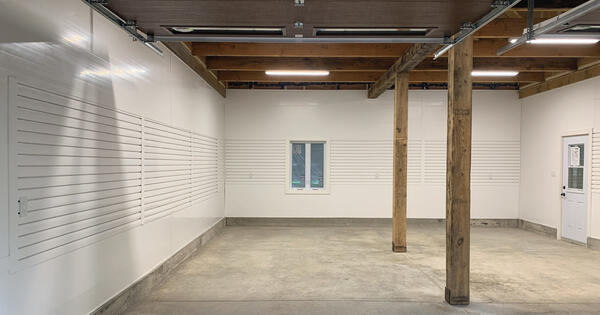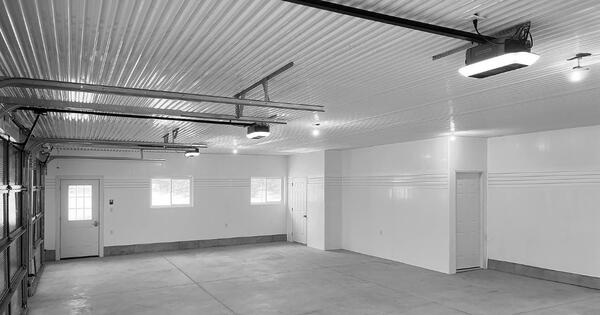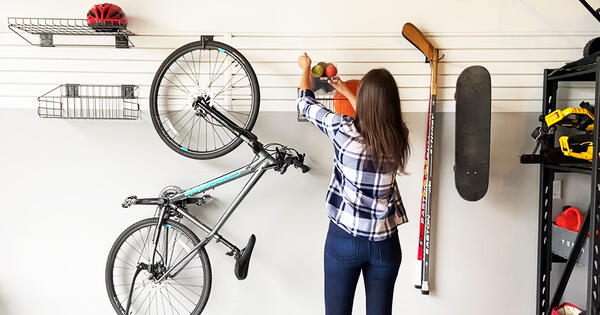This post was originally published in December 2022. Last updated: September 2024.
A garage isn’t just a place to park your car — with a little effort, it can become an extension of your home, adding both function and style. A well-designed garage ceiling can completely transform the space, making it brighter, more polished, and more useful. Whether you're aiming for a sleek, modern look or focusing on practicality, the right ceiling can elevate your garage to new heights. Let’s explore how you can make the most of this often-overlooked surface to create a finished space that’s not only functional but also visually appealing.
Considerations for Garage Ceilings
Before selecting a ceiling option for your garage, it’s important to think through a few key factors — these will directly impact your choice of materials and how well the ceiling performs over time.
- Moisture Resistance: Garages are often exposed to humidity, temperature fluctuations, and potential water exposure, especially if they aren’t climate-controlled. Choosing a material that can resist moisture will prevent mold, mildew, and deterioration. If you live in a high humidity area or park wet cars inside, moisture-resistant materials are critical.
- Durability: Garages endure a lot more wear and tear than other parts of the home. You’ll want materials that can stand up to impacts, temperature shifts, and even chemicals. Durable ceilings mean less frequent repairs and replacements over time.
- Ease of Maintenance: Since garages aren’t usually cleaned as often as interior spaces, you’ll want ceiling materials that are easy to maintain. Some materials can be wiped down or hosed off, while others may require more involved upkeep. Simpler maintenance can save you time and effort in the long run.
Impact on Material Choice and Design
These factors influence both the materials and the design of your garage ceiling. For example, moisture resistance might lead you toward PVC panels or treated wood rather than standard drywall, which could be prone to water damage. Durability might steer you away from delicate materials and toward more robust options like plywood or corrugated metal. Similarly, ease of maintenance might push you toward smooth, washable surfaces rather than textured finishes that collect dirt and dust. By considering these elements, you’ll not only ensure that your garage ceiling looks great but also that it stands up to the conditions it’ll face over time.



Garage Ceiling Materials for a Finished Look
Now that you know what to consider, let’s look at some popular materials for garage ceilings and how they stack up.
1. Drywall
Drywall is made from gypsum plaster between sheets of paper and is one of the most common choices for residential ceilings, including garages.
| Pros of Drywall | Cons of Drywall | ||
|---|---|---|---|
| Affordability: Drywall is one of the most cost-effective options for garage ceilings. It’s inexpensive, making it an appealing choice for homeowners looking to stay within a budget while achieving a clean, finished look. | Moisture Sensitivity: Standard drywall is vulnerable to moisture. If your garage experiences high humidity or water exposure (like from wet cars or snow), drywall can warp, swell, and develop mold, leading to expensive repairs. | ||
| Smooth Finish: Drywall offers a seamless, flat surface that can be easily painted, providing a clean and polished appearance. It’s perfect if you’re going for a traditional or modern aesthetic with a smooth, unobtrusive ceiling. | Installation Challenges: Installing drywall can be a labor-intensive process, requiring specialized tools and skills. For homeowners undertaking DIY garage projects, achieving a professional finish with drywall may be challenging, leading to frustration and potential imperfections. | ||
| Customizable: Drywall is highly customizable — whether you want to paint it to match your garage’s color scheme or add textures, it can be modified to fit virtually any design style. The flexibility to change colors or finishes over time is another significant advantage. | Maintenance: When drywall is damaged, repairs can be time-consuming and messy. Patching holes or dents often involves applying joint compound, sanding, and repainting, which can be more effort than some other ceiling options. |
2. Trusscore Wall&CeilingBoard
Trusscore Wall&CeilingBoard is a high-performance, PVC-based panel that’s engineered for durability, ease of maintenance, and moisture resistance, making it a great fit for garages.
| Pros of Trusscore Wall&CeilingBoard | Cons of Trusscore Wall&CeilingBoard | ||
|---|---|---|---|
| Moisture-Resistant: Unlike drywall, Trusscore panels are completely resistant to water. Whether it’s humidity, condensation, or even direct water exposure, these panels won’t absorb moisture, preventing issues like swelling, warping, or mold. | Cost: While Trusscore panels provide excellent performance, they come with a higher upfront cost compared to drywall. For homeowners on a tight budget, this may be a limiting factor despite the long-term benefits. | ||
| Durable: Trusscore panels are built to withstand impacts and resist dents, scratches, and other physical damage. Plus, PVC is resistant to pests such as termites and ants, reducing the risk of pest infestations in your garage. | Aesthetic Considerations: Some homeowners might prefer the more traditional look of materials like drywall or wood. The sleek, modern design of Trusscore may not appeal to everyone, especially those seeking a more classic appearance. | ||
| Low Maintenance: Trusscore Wall&CeilingBoard requires minimal upkeep. Its smooth surface can be wiped clean with a damp cloth or even hosed off if needed. It doesn’t absorb dirt or grime, making it perfect for garages that see a lot of mess or dust. | |||
| Easy to Install: Trusscore Wall&CeilingBoard is made for DIYers. The pre-finished panels weigh 40% less than drywall and — thanks to their pre-punched screw flange and tongue and groove interlocking system — can be installed four times faster with no special skills or tools required. That means you’ll be able to skip time-consuming activities like mudding, taping, priming, and painting to finish your project faster. |
3. Plywood and OSB (Oriented Strand Board)
Plywood and OSB are engineered wood products commonly used in construction. Both materials are durable, versatile, and more impact-resistant than drywall.
| Pros of Plywood and OSB | Cons of Plywood and OSB | ||
|---|---|---|---|
| Durability: Both plywood and OSB are stronger than drywall and can handle more abuse. This makes them a great option for garages that see a lot of physical activity, such as storing tools, bicycles, or heavy equipment. | Aesthetic Appeal: Plywood and OSB have a more industrial, unfinished look. To achieve a more polished appearance, you’ll need to paint, stain, or finish them, which can add to the overall cost and labor. | ||
| Moisture Resistance: While plywood and OSB aren’t entirely waterproof, they’re better at handling moisture than drywall — especially when sealed or treated. This makes them more resilient in garages where humidity levels fluctuate. | Maintenance: Over time, untreated or poorly sealed plywood and OSB can absorb moisture, leading to warping, rotting, or delamination. Proper sealing or finishing is essential to prevent long-term damage. | ||
| Easy to Work With: Plywood and OSB are relatively easy to cut, shape, and install, even for DIYers. They don’t require specialized tools, making them accessible for homeowners looking to tackle a ceiling project on their own. |
4. Corrugated Metal
Corrugated metal is a distinctive, industrial-style material that’s growing in popularity for both residential and commercial ceiling applications.
| Pros of Corrugated Metal | Cons of Corrugated Metal | ||
|---|---|---|---|
| Moisture Resistance: Corrugated metal panels are highly resistant to moisture, making them an excellent option for garages prone to humidity or direct water exposure. They won’t rust or corrode easily if properly treated, giving them a long lifespan even in challenging environments. | Noise: One drawback to using metal is that it can amplify sound. In a busy garage, noise from tools, doors closing, or heavy equipment can be louder with a metal ceiling. Some homeowners may find the echo and added noise distracting. | ||
| Durability: Metal panels are incredibly durable — they resist impacts, scratches, and even chemical exposure, which is ideal in a garage where heavy-duty work might be taking place. They’re built to last and require minimal upkeep over time. | Cost: Depending on the type of metal you choose (such as aluminum or steel), the cost can be higher than more traditional materials like drywall or plywood. The increased durability and unique look come with a price tag that might not suit every budget. | ||
| Industrial Look: Corrugated metal can give your garage a sleek, modern, or even rustic-industrial feel. The panels add texture and character to the space, making them a great choice for homeowners who want their garage to stand out from the norm. | Installation Complexity: Installing corrugated metal panels can be tricky and may require specialized tools or professional help. The panels need to be properly secured and aligned to avoid rattling or misalignment, which can complicate DIY projects. |

Integrating Lighting in Your Ceiling
Proper lighting can completely transform your garage from a dim, utilitarian space into a bright, functional area that’s pleasant to work in. Whether you’re using your garage for parking, storage, or as a workshop, the right lighting makes all the difference. By ensuring adequate and well-placed lighting, you’ll improve visibility and safety, while also enhancing the overall aesthetic of the space.
When you incorporate sufficient lighting, you’ll make it easier to find tools, perform tasks, and even highlight the design elements of your garage. Plus, a well-lit space feels more inviting — it becomes less of a dreary area to park the car and more of a comfortable, usable extension of your home. Lighting can also make the garage feel larger, as well-lit areas tend to open up a space and give it a cleaner, more organized appearance.
Types of Lighting and Ceiling Integration
There are several types of lighting you can integrate into your garage ceiling design, each offering different benefits depending on your needs.
LED Lighting
LED lights are energy-efficient, long-lasting, and bright, making them an excellent choice for garages. They offer a range of color temperatures — from cool white to daylight — allowing you to tailor the lighting to your preference. LEDs also generate very little heat, which is beneficial in enclosed spaces like garages.
Integration Tip!
LED strips or panels can be embedded directly into the ceiling for a sleek, modern look. You can also use LED fixtures that mimic traditional bulbs for more versatility. Recessing LED panels into drywall or Trusscore Wall&CeilingBoard can give your garage a minimalist, finished look while providing even light distribution.
Recessed Lighting
Recessed lights, often called can lights, are great for maintaining a clean ceiling profile. They’re unobtrusive and spread light evenly across the space, avoiding harsh shadows. Recessed lights can be directed to highlight specific areas, such as workbenches or storage units.
Integration Tip!
Install recessed lights at regular intervals across your ceiling to ensure consistent lighting. If your garage has multiple functions (parking, storage, workshop), consider zoning the lighting to focus on each area. Recessed lighting can be easily integrated into drywall or other ceiling materials without taking up headroom.
Fluorescent Lighting
Fluorescent lights have long been popular in garages because they produce a lot of light and cover wide areas efficiently. They’re relatively inexpensive and provide bright, cool light, making them useful for task-oriented spaces.
Integration Tip!
Fluorescent fixtures are typically mounted on the ceiling surface, but they can be recessed into ceilings like drywall or plywood for a more finished look. When placing fluorescent lights, ensure they’re spaced to eliminate shadows — especially over workbenches or storage areas.
The type of lighting you choose will depend on the garage’s primary function, your design preferences, and how much light you need. Mixing different types of lighting, such as combining recessed LEDs with fluorescent task lights, can create a balanced, well-lit environment.
Certain Ceiling Colors and Finishes Can Brighten Your Garage
The right color or finish on your garage ceiling can significantly enhance the brightness and overall feel of the space.
- Lighter Colors Reflect More Light: Using lighter colors — like white, light gray, or beige — on your garage ceiling will reflect more light and distribute it more evenly throughout the space. This helps maximize the effect of your lighting, making the garage feel brighter without needing extra light fixtures. Even if you only have a few light sources, lighter colors and paint can bounce that light around the room, reducing shadows and creating a more uniformly lit environment.
- Gloss Finishes Add Brightness and Openness: A gloss or semi-gloss finish like that of Trusscore Wall&CeilingBoard can also enhance the brightness in your garage. These finishes have reflective qualities that help scatter light throughout the room. Glossy finishes are ideal for ceilings because they create the illusion of more space by reflecting both natural and artificial light. This can make your garage feel larger, more open, and cleaner overall.
By carefully selecting lighter paint colors and gloss finishes, you can make your garage feel less like a dim storage area and more like a bright, polished extension of your home. The paint and finish you choose should complement your lighting design to create a cohesive, functional space.

Incorporating Storage Solutions into Garage Ceilings
Maximizing space in your garage often means thinking vertically. Incorporating storage solutions into your ceiling can free up valuable floor space and make your garage more organized and efficient.
Overhead Racks
Overhead racks are sturdy, metal shelving units mounted to the ceiling, providing storage space above your head. They’re typically anchored to the ceiling joists or studs, ensuring they can hold significant weight.
Use overhead racks for:
- Seasonal Items: Perfect for storing holiday decorations, camping gear, or other items you only use occasionally.
- Bulk Storage: If you purchase items like paper towels, toilet paper, or bottled water in bulk, overhead racks are great for keeping these out of the way yet accessible when needed.
- Long-Term Storage: Items you don’t need to access regularly, such as old files, memorabilia, or out-of-season clothing, can be stored on these racks to free up floor space.
Hanging Shelves
Hanging shelves are shelves that are attached to the ceiling or walls with brackets or metal chains. They’re often used for lighter items and provide easy access compared to overhead racks.
Use hanging shelves for:
- Tools and Supplies: Ideal for keeping tools, gardening supplies, or cleaning products within reach without cluttering the workbench or floor.
- Small Containers: Store small bins or boxes containing nails, screws, or other small hardware items. This keeps them organized and easily accessible.
- Frequently Used Items: Anything you need to grab often, such as extension cords, car care products, or small power tools, can be stored on these shelves for convenience.
Pulley Systems
A pulley system consists of ropes or cables and a set of pulleys that allow you to lift and lower items to and from the ceiling. This system can handle heavier loads and is particularly useful in garages with higher ceilings.
Use a pulley system for:
- Bicycles: Perfect for storing bikes off the floor, keeping them out of the way while making them easy to lower when you need them.
- Kayaks or Canoes: If you have watercraft, a pulley system allows you to store them overhead without taking up valuable floor space.
- Heavy Tools or Equipment: Use the pulley system to hoist and store heavy tools or machinery, like ladders or lawn equipment, making them accessible but not obtrusive.
Each of these storage solutions can help you maximize the available space in your garage, ensuring it stays organized and functional. By choosing the right solution for your needs, you can keep your garage tidy and make the most of its vertical space.
A bright, finished garage ceiling does more than just enhance the aesthetics of the space — it also improves functionality and lighting, making your garage a place you’ll want to use more often. Take the time to evaluate your needs and design preferences before starting your project, and you’ll create a garage ceiling that’s as functional as it is beautiful.






